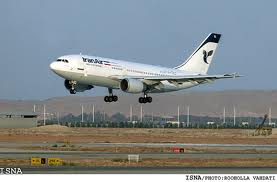
 The crash of an IranAir Boeing 727 has left 72 dead and 33 injured. According to reports, the plane attempted to land but aborted due to bad weather. During a 2nd attempt, it disappeared off the radar crashing in a village area near Orumiyeh and breaking into three pieces. Surprisingly, there was no fire. Some passengers managed to out of the plane themselves while nearby villagers took several injured to hospital.
The crash of an IranAir Boeing 727 has left 72 dead and 33 injured. According to reports, the plane attempted to land but aborted due to bad weather. During a 2nd attempt, it disappeared off the radar crashing in a village area near Orumiyeh and breaking into three pieces. Surprisingly, there was no fire. Some passengers managed to out of the plane themselves while nearby villagers took several injured to hospital.Rescue operations were hampered by seventy centimeters (27 inches) of snow and thick fog but news outlets are saying that all the bodies and the injured have been transferred to different hospitals in the city of Orumiyeh.
The exact reason of the crash remains unknown at the moment but common opinion is that bad weather was the cause. State television apparently reported that the black boxes have been recovered and their analysis will hopefully shed some light on the accident.
Iran has a history of regular air accidents which have been blamed on its aging aircraft. Years of international sanctions as well as the country’s general policy of shunning the United States has left many of its planes without spare parts and in a poor state of repair. As an alternative, Iran had turned to Russia for both planes and parts but after the fall of the Soviet state, it too has become less of a reliable source to support its fleet of aircraft.
Iran’s most notable crashes
· July 2009; 168 killed Soviet-designed Tupolev catches fire in mid-air and plunged flaming into farmland northeast of Tehran
· November 2006; all 39 people on board killed including 30 Revolutionary Guards military plane crashed on takeoff at Tehran’s Mehrabad airport
· December 2005; 108 killed Lockheed transport plane crashed into a high-rise housing block outside Tehran
· February 2003; 302 people on board killed Russian-made Ilyushin 76 crashes in the mountains of southeastern Iran. This was supposedly Iran’s worst air disaster
On July 6, 2010, the BBC reported that the European Union had banned most of Iran Air’s jets from flying to the EU because of safety concerns. The ban would affect Airbus A320, Boeing 727 and 747 jets – two-thirds of Iran Air’s fleet. The ban was said to be over safety concerns and nothing to do sanctions imposed on Iran because of its nuclear programme.
********************************************
A history lesson: Iran Air Flight 655
Iran Air Flight 655 (IR655), was a civilian jet airliner shot down by US missiles on 3 July 1988, over the Strait of Hormuz, toward the end of the Iran–Iraq War. The aircraft, an Airbus A300B2-203 operated by Iran Air, was flying from Bandar Abbas, Iran, to Dubai, United Arab Emirates, when it was destroyed by the U.S. Navy’s guided missile cruiser USS Vincennes, killing all 290 passengers and crew aboard, including 66 children, ranking it seventh among the deadliest airliner fatalities. It was the highest death toll of any aviation incident in the Indian Ocean and the highest death toll of any incident involving an Airbus A300 anywhere in the world. Vincennes was traversing the Strait of Hormuz, inside Iranian territorial waters, and at the time of the attack IR655 was within Iranian airspace.
According to the US government, the crew mistakenly identified the Iranian Airbus A300 as an attacking F-14 Tomcat fighter. The Iranian government maintained that the Vincennes knowingly shot down the civilian aircraft. The event generated a great deal of controversy and criticism of the US. Some analysts have blamed US military commanders and the captain of the Vincennes for reckless and aggressive behavior in a tense and dangerous environment.
In 1996, the United States and Iran reached "an agreement in full and final settlement of all disputes, differences, claims, counterclaims" relating to the incident at the International Court of Justice. As part of the settlement, the United States agreed to pay US$61.8 million, an average of $213,103.45 per passenger, in compensation to the families of the Iranian victims. However, the United States has never admitted responsibility, nor apologized to Iran.
Click HERE to read more from William Belle.
You can publish this article on your website as long as you provide a link back to this page.

Be the first to comment